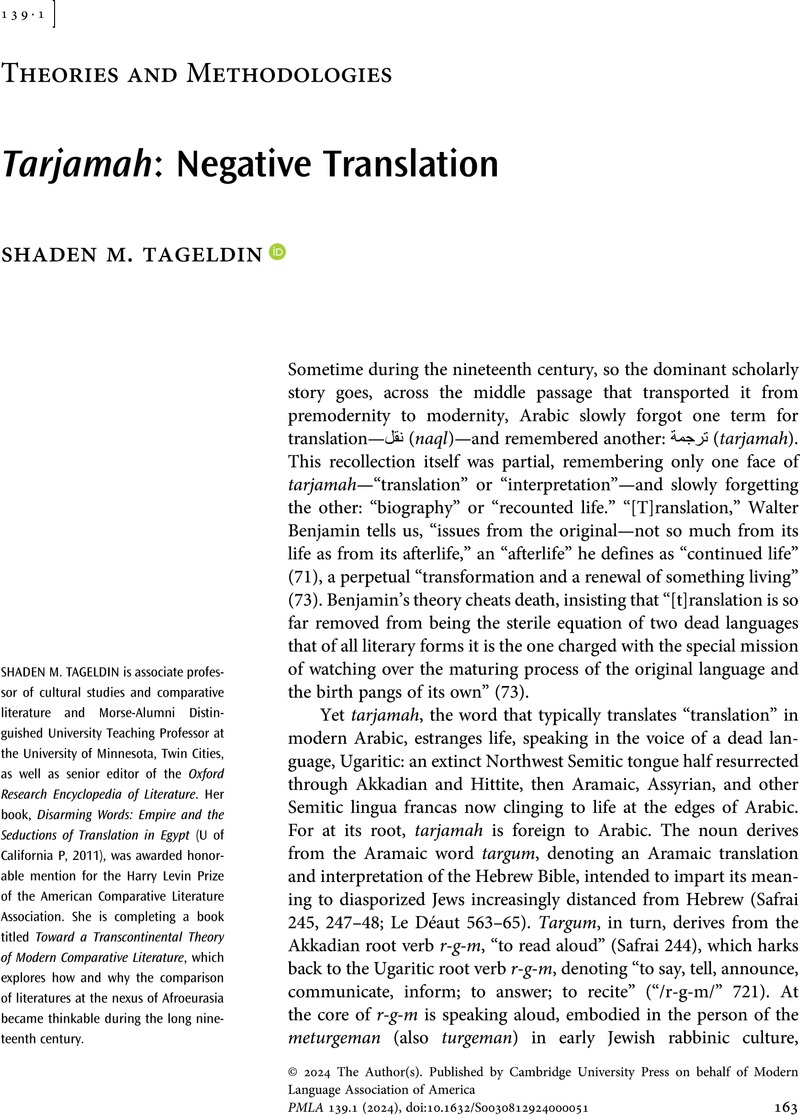No CrossRef data available.
Article contents
Tarjamah: Negative Translation
Published online by Cambridge University Press: 17 April 2024
Abstract
An abstract is not available for this content so a preview has been provided. Please use the Get access link above for information on how to access this content.

- Type
- Theories and Methodologies
- Information
- Copyright
- Copyright © 2024 The Author(s). Published by Cambridge University Press on behalf of Modern Language Association of America
References
Works Cited
Albright, W. F. “A Catalogue of Early Hebrew Lyric Poems (Psalm LXVIII).” Hebrew Union College Annual, vol. 23, no. 1, 1950–51, pp. 1–39.Google Scholar
Benjamin, Walter. “The Task of the Translator.” Illuminations, edited and introduced by Arendt, Hannah, translated by Zohn, Harry, Schocken Books, 1968, pp. 69–82.Google Scholar
Bustānī, Buṭrus al-. كتاب محيط المحيط [Kitāb Muḥīṭ al-Muḥīṭ]. Vol. 1, Beirut, 1867.Google Scholar
Colla, Elliott. “Dragomen and Checkpoints.” The Translator, vol. 21, no. 2, 2015, pp. 132–53, https://doi.org/10.1080/13556509.2015.1071523.CrossRefGoogle Scholar
Ḍayf, Shawqī. الترجمة الشخصية [al-Tarjamah al-Shakhṣiyyah]. Dār al-Maʿārif, 1956.Google Scholar
Fayrūzābādī, Majd al-Dīn Muḥammad ibn Yaʿqūb al-. القاموس المحيط [al-Qāmūs al-Muḥīṭ]. Vol. 4, Al-Maṭbaʿah al-Ḥusayniyyah al-Miṣriyyah, 1330 AH [1911 CE] and 1332 AH [1913 CE].Google Scholar
Fayyūmī, Aḥmad ibn Muḥammad ibn ʿAlī al-Muqrī al-. كتاب المصباح المنير في غريب الشرح الكبير للإمام الرافعي [Kitāb al-Miṣbāḥ al-Munīr fī Gharīb al-Sharḥ al-Kabīr li-l-Imām al-Rāfiʿī]. Vol. 1, Al-Maṭbaʿah al-ʿĀmirah al-Bahiyyah, 1312 AH [1895 CE].Google Scholar
Gutas, D., et al. “Tardjama.” Encyclopaedia of Islam, edited by P. Bearman et al., 2nd ed., Brill, 2012, http://dx.doi.org/10.1163/1573-3912_islam_COM_1178.CrossRefGoogle Scholar
Ḥasan, Muḥammad ʿAbd al-Ghanī. التراجم والسير [al-Tarājim wa-l-Siyar]. Dār al-Maʿārif, 1955.Google Scholar
Hassan, Waïl S. Translator's introduction. Thou Shalt Not Speak My Language, by Kilito, Abdelfattah, translated by Hassan, , Syracuse UP, 2008, pp. vii–xxvi.Google Scholar
Ibn, Manẓūr. لسان العرب [Lisān al-ʿArab]. New ed., edited by ʿAbd Allāh ʿAlī al-Kabīr et al., Dār al-Maʿārif, 1981. 6 vols.Google Scholar
Issa, Rana. The Modern Arabic Bible: Translation, Dissemination, and Literary Impact. Edinburgh UP, 2023.Google Scholar
Johnson, Rebecca C. Stranger Fictions: A History of the Novel in Arabic Translation. Cornell UP, 2020.Google Scholar
Kesrouany, Maya I. Prophetic Translation: The Making of Modern Egyptian Literature. Edinburgh UP, 2019.Google Scholar
Lane, Edward William. مد القاموس : An Arabic-English Lexicon [Madd al-Qāmūs: An Arabic-English Lexicon]. Bk. 1, pt. 1, Williams and Norgate, 1863.Google Scholar
Le Déaut, Roger. “The Targumim.” The Cambridge History of Judaism: Vol. 2: The Hellenistic Age, edited by Davies, W. D. and Finkelstein, Louis, Cambridge UP, 1989, pp. 563–90.Google Scholar
Musawi, Muhsin J. al-. “The Medieval Islamic Literary World-System: The Lexicographic Turn.” Mamlūk Studies Review, vol. 17, 2013, pp. 43–71, https://doi.org/10.6082/M1Q52MSK.Google Scholar
Musawi, Muhsin J. al-. “The Republic of Letters: Arab Modernity? [Pt. I].” Cambridge Journal of Postcolonial Literary Inquiry, vol. 1, no. 2, 2014, pp. 265–80, https://doi.org/10.1017/pli.2014.10.CrossRefGoogle Scholar
Polizzotti, Mark. Sympathy for the Traitor: A Translation Manifesto. MIT Press, 2018.CrossRefGoogle Scholar
Rabin, Chaim. “Hittite Words in Hebrew.” Orientalia, Nova series, vol. 32, no. 2, 1963, pp. 113–39.Google Scholar
Rashwan, Hany. “Intellectual Decolonization and Harmful Nativism: Arabic Knowledge Production of Ancient Egyptian Literature.” Interventions: International Journal of Postcolonial Studies, 2023, https://doi.org/10.1080/1369801X.2022.2161054.CrossRefGoogle Scholar
Reynolds, Dwight F., et al. Interpreting the Self: Autobiography in the Arabic Literary Tradition. Edited by Reynolds, U of California P, 2001.CrossRefGoogle Scholar
“/r-g-m/.” A Dictionary of the Ugaritic Language in the Alphabetic Tradition, by del Olmo Lete, Gregorio and Sanmartín, Joaquín, translated and edited by Watson, Wilfred G. E., 3rd rev. ed., pt. 1, Brill, 2015, pp. 721–22.CrossRefGoogle Scholar
Rothman, E. Natalie. The Dragoman Renaissance: Diplomatic Interpreters and the Routes of Orientalism. Cornell UP, 2021.CrossRefGoogle Scholar
Sacks, Jeffrey. Iterations of Loss: Mutilation and Aesthetic Form, al-Shidyaq to Darwish. Fordham UP, 2015.Google Scholar
Safrai, Zeev. “The Targums as Part of Rabbinic Literature.” The Literature of the Sages: Second Part: Midrash and Targum, Liturgy, Poetry, Mysticism, Contracts, Inscriptions, Ancient Science and the Languages of Rabbinic Literature, edited by Safrai, Shmuel et al., Royal Von Gorcum / Fortress Press, 2006, pp. 243–78.Google Scholar
Sakai, Naoki. Translation and Subjectivity: On “Japan” and Cultural Nationalism. Foreword by Morris, Meaghan, U of Minnesota P, 1997.Google Scholar
Scott Deuchar, Hannah. “Loan-Words: Economy, Equivalence, and Debt in the Arabic Translation Debates.” Comparative Literature Studies, vol. 57, no. 2, 2020, pp. 187–209, https://doi.org/10.5325/complitstudies.57.2.0187.CrossRefGoogle Scholar
Shamma, Tarek. Introduction. Anthology of Arabic Discourse on Translation, edited by Shamma, and Myriam Salama-Carr, , Routledge, 2022, pp. 1–30.Google Scholar
Shinan, Avigdor. “Live Translation: On the Nature of the Aramaic Targums to the Pentateuch.” Prooftexts, vol. 3, no. 1, 1983, pp. 41–49.Google Scholar
Tageldin, Shaden M. “Hugo, Translated: The Measures of Modernity in Muḥammad Rūḥī al-Khālidī's Poetics of Comparative Literature.” PMLA, vol. 138, no. 3, May 2023, pp. 616–38, https://doi.org/10.1632/S0030812923000573.Google Scholar
Ṭahṭāwī, Rifāʿah Rāfiʿ al-. “مقدمة المترجم ” [“Muqaddimat al-Mutarjim”]. مواقع الأفلاك في وقائع تليماك [Mawāqiʿ al-Aflāk fī Waqāʾiʿ Tilīmāk], Al-Maṭbaʿah al-Sūriyyah, [1870?], pp. 2–23.Google Scholar
Ṭahṭāwī, Rifāʿah Rāfiʿ al-. تخليص الإبريز الی تلخيص باريز أو الديوان النفيس بإيوان باريس [Takhlīṣ al-Ibrīz ilā Talkhīṣ Bārīz aw al-Dīwān al-Nafīs bi-Īwān Bārīs]. Dār al-Ṭibāʿah al-Khidīwiyyah, 1250 AH [1834 CE].Google Scholar
ترجم [“Tarjama”]. معجم الدوحة التاريخي للغة العربية [Muʿjam al-Dūḥah al-Tārīkhī li-l-Lughah al-ʿArabiyyah], dohadictionary.org/dictionary/ترجم .Google Scholar
ترجمة [“Tarjamah”]. معجم الدوحة التاريخي للغة العربية [Muʿjam al-Dūḥah al-Tārīkhī li-l-Lughah al-ʿArabiyyah], dohadictionary.org/dictionary/ترجمة .Google Scholar
ترجمان [“Turjumān”]. معجم الدوحة التاريخي للغة العربية [Muʿjam al-Dūḥah al-Tārīkhī li-l-Lughah al-ʿArabiyyah], dohadictionary.org/dictionary/ترجمان .Google Scholar
Yeats, W. B. “Among School Children.” The Collected Poems of W. B. Yeats, Macmillan, 1982, pp. 242–45.Google Scholar
Zachs, Fruma, and Dror, Yehudit. “The Muḥīṭ al-Muḥīṭ Dictionary: The Transition from Classical to Modern Arabic Lexicography.” Journal of Arabic and Islamic Studies, vol. 20, 2020, pp. 15–32, https://doi.org/10.5617/jais.7853.CrossRefGoogle Scholar


